
Coverage by The Guardian and the WSJ.

Coverage by The Guardian and the WSJ.
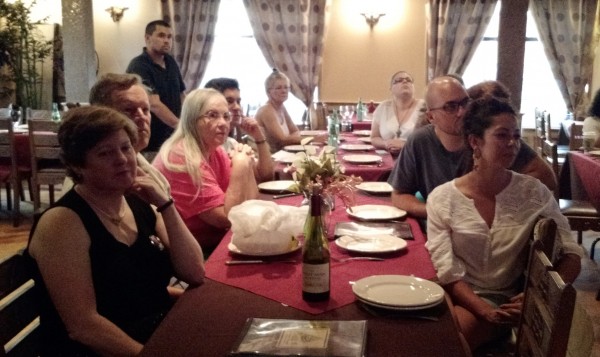 August Environment & Climate Justice Green Drinks Paterson Area
August Environment & Climate Justice Green Drinks Paterson Area
27 August 2015 at 12 noon
Sultan Restaurant
429 Crooks Ave, Paterson, New Jersey 07011
Everyone is welcome 🙂 and there’s never a meeting charge.
Mayor información – More information:
ejgreendrinks.org | 201-477-8711
ABOUT GREEN DRINKS
Green Drinks are gatherings where we discuss Environmental Justice, climate change and sustainable living issues in English and Spanish!
A lot of knowledge is shared around the table each month along with tasty food and good conversation. Come spend a couple interesting hours with the friendliest bunch of EJ nuts you’ll ever meet.
Please support our host venue by eating or drinking something while we chat.
ORGANIZERS
Kimi Wei, Ivan Gomez Wei, Ariel Lopez Wei, Joseph Dunsay and Sally Gellert
SEPT 2015 NJECJ GREEN DRINKS SCHEDULE
Newark cancelled this month due to Labor Day
Hackensack WED 16 SEPT 7-9 PM
Paterson date TBA
(more at http://ejgreendrinks.org/)
 I know it seems crazy, but the way some our favorite foods are grown and manufactured is doing fantastic harm to our world. Conflict palm oil is one product that harms the environment and is widely used in mass produced baked goods including crackers and GirlScout cookies … so the Rainforest Action Network (RAN) is putting together a coalition of leaders who will learn to lead a movement to protect rainforests, the ecosystems they are home to, the air they clean and orangutans. Maybe you’d like to sign on.
I know it seems crazy, but the way some our favorite foods are grown and manufactured is doing fantastic harm to our world. Conflict palm oil is one product that harms the environment and is widely used in mass produced baked goods including crackers and GirlScout cookies … so the Rainforest Action Network (RAN) is putting together a coalition of leaders who will learn to lead a movement to protect rainforests, the ecosystems they are home to, the air they clean and orangutans. Maybe you’d like to sign on.
CONFLICT PALM OIL: Are your cookies causing orangutan extinction?
We may not be able to see it, but Conflict Palm Oil has become ubiquitous in our everyday lives. It is found in roughly half the packaged products sold in US grocery stores, including favorite snack foods like ice cream, cookies, crackers, chocolate products, cereals, doughnuts and potato chips. In fact, palm oil is likely present in some form in nearly every room of your home.
Demand for palm oil is skyrocketing worldwide. The recent spike in use by the US snack food industry is due in large part to Conflict Palm Oil being used as a replacement for controversial trans fats. The oil is extracted from the fruit of oil palms native to Africa, now grown primarily in Indonesia and Malaysia.
Conflict Palm Oil production is now one of the world’s leading causes of rainforest destruction. Unchecked expansion is pushing new plantations deep into the heart of some of the world’s most culturally and biologically diverse ecosystems. Irreplaceable wildlife species like the Sumatran Rhino, Sumatran Elephant and the Sumatran and Borneo orangutan are being driven to the brink of extinction.
But Conflict Palm Oil is not only a local problem. The clearing of rainforests and carbon-rich peatlands for new plantations is releasing globally significant carbon pollution, making Conflict Palm Oil a major driver of human induced climate change.
If this issue concerns you, maybe you’d like join RAN’s Palm Oil Action Team and learn how to take the lead in stopping rainforest destruction by the snack food industry.
Palm Oil Action Leaders: Building a Movement to Cut Conflict P…
Ever wonder how you can fight deforestation, human rights abuses, child and forced labor, and the extinction of iconic species like the orangutan in YOUR community? RAN's Palm Oil Action Team organizes in their communities and online, around the world, to pressure the biggest corporations on the world to cut Conflict Palm Oil. The Snack Food 20 corporations would hate it – and we would love it – if you joined the Palm Oil Action Team. Check out the video of some of our local leaders, then get involved at http://a.ran.org/a2N
Posted by Rainforest Action Network on Tuesday, 4 August 2015
An animal friend speaking through sign language to tell about his home needing protection from conflict palm oil destruction is Strawberry the Orangutan. There are only about 60,000 wild orangutans left.
The Sierra Club comments,
The Board of Public Utilities (BPU) is putting together the 2015 Energy Master Plan (EMP) which will help determine where we get our energy from in New Jersey. The plan decides New Jersey’s priorities for clean AND dirty energy and can also set limits on how much energy we waste.
Compelling statements from environmental justice (EJ) and environmental groups were made before the 2011 plan was adopted. But community voices were ignored, with operation of existing dirty fossil fuel and incinerators not only continuing unabated, but expanding. A new 655 megawatt natural gas plant was situated in Newark’s already heavily polluted Ironbound neighborhood; and several other dirty fuel facilities were located around the state.
Let’s not allow community demands for clean energy to lose impetus because New Jersey state has recently opted to label as “clean energy” both nuclear energy and fracked natural gas – which are anything but … are also dangerous to the environment and cause health issues too.
Since the facilitators of public hearings do not listen to the community anyway, the EJ community is taking their objections, concerns and demand for real solutions to the street and demanding JUSTICE across the board, including: Energy Justice, Environmental Justice, Climate Justice. Stefan Ali of the ICC writes,
The last time there were public hearings on the Energy Plan, industry was allowed to speak first and concerned residents spoke at the end when the media had left. We want to make our voices heard by protesting and rallying.
The August 11 action will not be about standing around listening to an endless roster of speakers. Instead, there will be activities, performances, music and some fun street puppets as well. Please join in and support #actonclimate!
Please email or phone Molly Greenberg at 973.817.7013 x217 or 218 for additional information.
Should you wish to comment on the New Jersey Energy Master Plan 2015 and the state’s energy future, you can do so in person or electronically. Here are your options:
Resources:
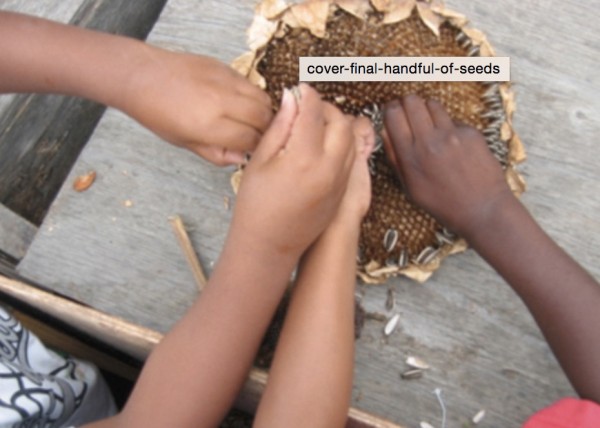 Bookmark this post and visit to see future additions.
Bookmark this post and visit to see future additions.
“A Handful of Seeds” publication on seed saving and seed study for educators, a 91 page full color illustrated guide with lessons linked to California Educational Standards, practical information on seed saving in the school garden, seed history and lore. By the Occidental Arts and Ecology Center School Garden Program.
Please add to this list by sharing a resource you know in a comment.
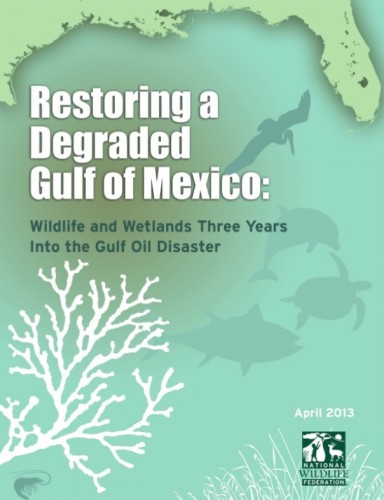 The government trustees charged with restoring the Gulf have released 10 new projects, including two that will protect bluefin tuna and sea turtles. This suite of new projects is the fourth phase of the Natural Resource Damage Assessment early restoration process, funded by a $1 billion “down payment” from BP to restore the damage caused by the oil disaster.
The government trustees charged with restoring the Gulf have released 10 new projects, including two that will protect bluefin tuna and sea turtles. This suite of new projects is the fourth phase of the Natural Resource Damage Assessment early restoration process, funded by a $1 billion “down payment” from BP to restore the damage caused by the oil disaster.
We need your help. The trustees are calling for comments on the 10 proposed projects by July 6 – so, add your comment today!
Here’s what I wrote (first paragraph are my words):
Diversity is the invisible undercurrent that powers our world. And the sea covers most of our planet. We need to protect and nurture natural life and marine victims of the Gulf Oil tragedy. Please, act on behalf of a people and a planet who need your help.
Canned message follows (written by Ocean Conservancy):
I am writing in support of the pelagic longline bycatch reduction and sea turtle early restoration projects, proposed in phase IV of the Natural Resource Damage Assessment early restoration process.
For too long, we have seen the list of impacts to deep water species grow, while the projects to restore those species never materialized. From dolphins dying in record numbers, to corals covered in oil and millions of gallons of oil sitting on the seafloor, a troubling story is unfolding offshore. It is past time to begin restoring our impacted deep water resources and habitats. Only by addressing restoration in an integrated and comprehensive way — from the coast to the deep water can our impacted habitats, wildlife and coastal communities fully recover.
With these two projects, I am encouraged to see the trustees finally begin to restore the Gulf not just on the coast but beyond the shore, where the BP oil disaster began. These projects represent the comprehensive approach that we’ve been hoping to see in the five years since the disaster began. If we want to truly restore the Gulf, we must focus on both the coast and the deep water — our communities, culture and livelihoods depend on it.


Thanks to Scott Reddin, I just learned that a comment I made to the NJ Department of Environmental Protection (DEP) on Christie’s Exxon-Mobil settlement was quoted in an article on northjersey.com. This is the settlement where Christie turns a $9B settlement for polluting our state into a $250M one – and then takes the $250M.
Kimi Wei of Fair Lawn wrote that Exxon “should be made to understand that the earth is a common asset belonging to all. It cannot be used by some for profit while many others experience loss of enjoyment and access to the land.”
Almost sounds profound, right?
Senator Raymond Lesniak is taking a strong stand in favor of making Exxon-Mobil pay what the damages are worth. He’s got a petition going. Let’s support his stand with our signatures and prayers, and see how far we can move the dial towards fair.
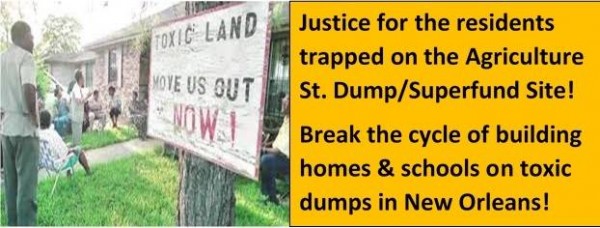 The Campaign for Toxic-Free Schools in New Orleans and Louisiana reports that the Louisiana House of Representatives voted unanimously in favor of House Bill 180, which would prohibit the construction of new schools on waste sites. The bill now goes to the Louisiana Senate – let’s all pray that it passes!
The Campaign for Toxic-Free Schools in New Orleans and Louisiana reports that the Louisiana House of Representatives voted unanimously in favor of House Bill 180, which would prohibit the construction of new schools on waste sites. The bill now goes to the Louisiana Senate – let’s all pray that it passes!
An April 2015 Times-Picayune article provides background on this issue.
California farmers are buying fracking waste liquid from the natural gas extraction companies that use high-pressure liquid cocktails – mixed with massive amounts of potable water – to get natural gas out of shale deposits and sell the gas overseas. What are they doing with that radioactive waste? The LA Times reports: watering their crops with it, that’s what.
Oh yeah, the crops we eat. Some farmers are using fracking waste for as much as half of their ‘water’ supply. But this picture of fracking waste looks nothing like water, does it?
A scientist who sometimes consults for the EPA took fracking liquid samples at 10 sites over an 8 mile canal where it’s channelled to farmers and found,
The samples (Scott) Smith collected contained acetone and methylene chloride, solvents used to degrease equipment or soften thick crude oil, at concentrations higher than he said he had seen at oil spill disaster sites. The water also contained C20 and C34, hydrocarbons found in oil, according to ALS Environmental, the lab that analyzed Smith’s samples.
Methylene chloride and acetone are used as solvents in many industrial settings. Methylene chloride is classified as a potential carcinogen.
The farmers seem to think none of this is a problem, but then again, these are the same people that for years have taking 80% of drought-ridden California’s potable water supply to grow commercial crops. How much can their judgement be trusted?
“But on the plus side,” as Facebooker Ben Ogden points out, “all the veggies will be easier to find in the dark…”
I like one Grist reporter’s comment on the story. Now, I can’t wait until June 15 rolls around and the American public gets to learn exactly what nefarious chemicals are in fracking liquid.
There’s a certain amount of WTF to all this — because we don’t even know what’s in this fracking waste, at least not until June 15. That’s when California’s fracking regulations kick in and force oil companies to disclose the chemicals they are using. I mean, maybe just wait to find that out before using it to water our cherries?
Thanks William Rivers Pitt for making me aware of this disturbing, but important, news.
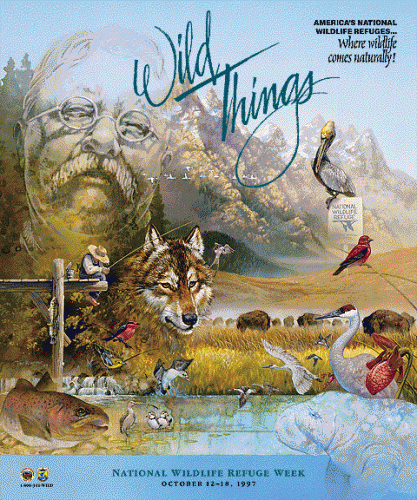 New data from the highly secretive arm of the U.S. Agriculture Department known as Wildlife Services reveals it killed more than 2.7 million animals during fiscal year 2014, including wolves, coyotes, bears, mountain lions, beavers, foxes, eagles and other animals deemed pests by powerful agricultural, livestock and other special interests.
New data from the highly secretive arm of the U.S. Agriculture Department known as Wildlife Services reveals it killed more than 2.7 million animals during fiscal year 2014, including wolves, coyotes, bears, mountain lions, beavers, foxes, eagles and other animals deemed pests by powerful agricultural, livestock and other special interests.
Despite increasing calls for reform after the program killed more than 4 million animals in 2013, the latest kill report indicates the reckless slaughter of wildlife continues, including 322 gray wolves, 61,702 coyotes, 580 black bears, 305 mountain lions, 796 bobcats, 454 river otters, 2,930 foxes, three bald eagles, five golden eagles and 22,496 beavers. The program also killed 15,698 black-tailed prairie dogs and destroyed more than 33,309 of their dens.
“It’s sickening to see these staggering numbers and to know that so many of these animals were cut down by aerial snipers, deadly poisons and traps,” said Amy Atwood, a senior attorney at the Center for Biological Diversity. “These acts of brutality are carried out every day, robbing our landscapes of bears, wolves, coyotes and other animals that deserve far better. Wildlife Services does its dirty work far from public view and clearly has no interest in cleaning up its act.”
Agency insiders have revealed that the agency kills many more animals than it reports.
Many animals – especially wolves, coyotes and prairie dogs – were targeted and killed on behalf of livestock grazers or other powerful agricultural interests. Wildlife Services does not reveal how many animals were wounded or injured, but not killed.
The new data also show that hundreds animals were killed unintentionally including 390 river otters, as well as hundreds of badgers, black bears, bobcats, coyotes, foxes, jackrabbits, muskrats, raccoons, skunks, opossums, porcupines and 16 pet dogs.
The data show that the federal program has refused to substantially slow its killing despite a growing public outcry, an ongoing investigation by the Agriculture Department’s inspector general, and calls for reform by scientists, members of Congress and nongovernmental organizations.
“Wildlife Services continues to thumb its nose at the growing number of Americans demanding an end to business as usual,” said Atwood. “This appalling and completely unnecessary extermination of American wildlife must stop.”
Just since 1996 Wildlife Services has shot, poisoned and strangled by snare more than 27 million native animals.